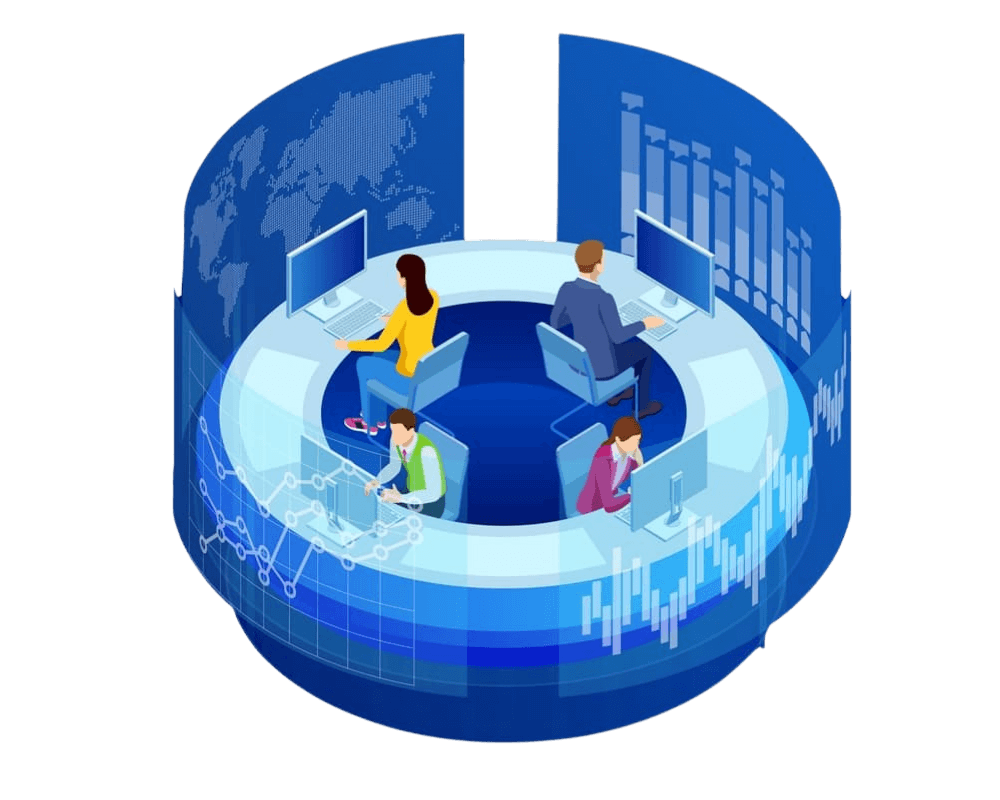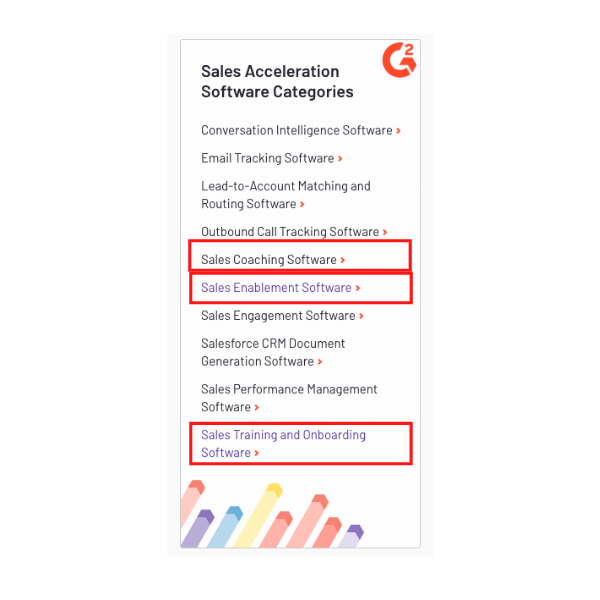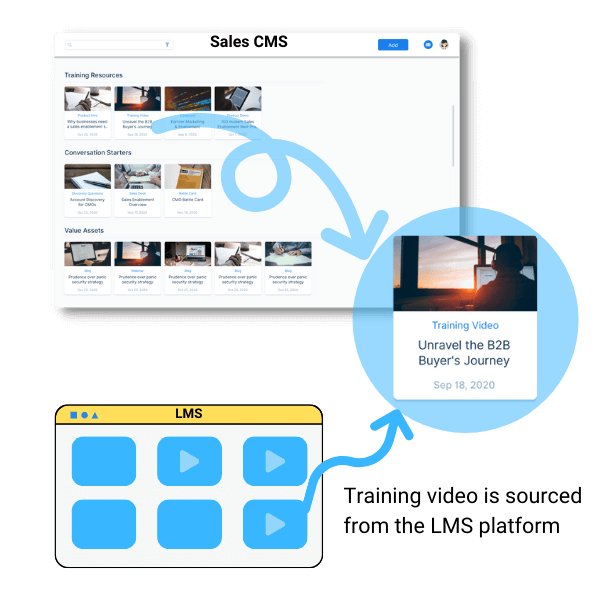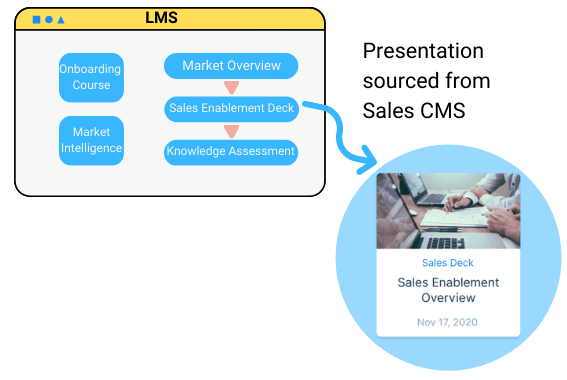Sales Enablement is a broad discipline that covers multiple enablement functions. According to Sirius Decision, sales enablement’s goal is to ensure that every seller has the required knowledge, skills, processes, and behaviors to optimize every interaction with buyers.
More here on “What is Sales Enablement?“
Sales Training/Coaching and Sales Content Enablement are two primary pillars of a Sales Enablement program. If you check reputed sources like G2, that do vendor comparison, they have multiple categories that cover training and enablement. For instance, G2 has three sub-categories that can be considered as sales enablement:
- Sales Coaching Software
- Sales Enablement Software
- Sales Training and Onboarding Software
Therefore, it is not surprising that when sales enablement and marketing teams consider sales enablement investments, they face a dilemma. Should they invest in Sales Training, or should they invest in Sales Content Enablement? Clearly, there is a lot of confusion in the market between these two vital sales enablement solution areas. Buyers are confused about these two distinct use cases. And they frequently mix up the benefits of two types of solutions.
- Learning Management Systems (LMS): LMS tools are commonly used to meet Sales Training needs.
- Sales Content Management Systems (Sales CMS): Sales Enablement Platforms are commonly used to organize and curate relevant collateral in the form of Sales CMS.
This post discusses how LMS and Sales CMS are serving different but important sales enablement use cases. We will also discuss how they differ in their usage and functionality. And finally, we will discuss how organizations that have invested in both an LMS and a Sales CMS can streamline enablement processes with integrations between these two tools.
What is a Learning Management System?
Your company’s sales reps need training in various aspects of the business to sell successfully. They need to understand your offer, what problems your offering or service solves, why customers and users benefit from your offering versus that of your competitors, etc. They also need to be skilled in following the sales process and tools that the company is using to support sales.
Enterprises invest in Learning Management Systems (LMS) to achieve this task.
As defined by Wikipedia, an LMS is a software application for the administration, documentation, tracking, reporting, automation, and delivery of educational courses, training programs, or learning and development programs.
As you will see from the above definition, an LMS tool is applicable beyond sales training to other learning needs e.g. Corporate Learning, Employee Onboarding, Employee Compliance Training, etc. For the context of this post, we will discuss an LMS solution in the light of sales training and coaching and its use to manage digital learning content for sales users.
In the last decade, there have been different flavors of Sales LMS solutions. For instance, there are several Sales Readiness and Sales Coaching solutions that are available in the market. However, the end goal is the same. You need an LMS (or a Sales Readiness/Coaching) solution to help train and educate sales users so that they are successful at their jobs.
What are the key features of an LMS solution?
- Create online course material
- Can add existing material
- Create new material
- Define assessment criteria/tests
- Organize your courses
- Deliver your courses
- Courses taken
- Measure learners (sales users) engagement
- Track learners assessment and certification
3 use cases when you use a Sales LMS tool
- Sales Onboarding
- Product or Solution Launch
- Sales Skills Training
And with the current trend of a remote and distributed workforce, virtual training is a necessity for successful learning outcomes.
What are the popular LMS tools for Sales Training?
There is a wide range of Sales LMS tools available in the market. Here are some of the popular tools that are used by enterprises for achieving sales training and learning objectives.
- MindTickle
- Lessonly
- Docebo
- Saleshood
- Brainshark
- Leveljump
- Workramp
- Allego
Here are some links from G2 which will help you to understand more about the sales training, on-boarding and sales coaching contenders.
G2 Grid for Sales Training and On-Boarding
What is a Sales Content Management System?
Today, the B2B buying process is complex. And your prospects and buyers are looking to your sales team members to help navigate the purchase process. Your sales users need access to the right information at the right time to build trust with prospects and win deals. And sales and marketing content plays a big role in this endeavor.
Sales Enablement and Marketing teams use a Sales Content Management System (also popularly referred to as a Sales Enablement Platform) to organize, curate and share sales relevant content with the sales teams. With a Sales CMS tool, the sales users have one solution to access all the information and content they need to do their jobs.
Modern sales content enablement platforms also support features that allow sales reps to share the right content with the right experience with their prospects and customers and track engagement.
Ten years ago, it seemed that only large organizations with large sales teams will benefit from a sales content enablement platform. However, that is no longer the case. The benefits of sales enablement are also applicable to organizations with a fewer number of sales employees. It is common for enterprises with 15 or 20 sales users to invest in a sales content enablement platform.
In fact, the need for a Sales CMS is more dependent on the complexity of your selling process and your market characteristics than the size of the sales team.
What are the key features of a Sales CMS solution?
- Central content repository
- Ability to support files, links, text
- Organize content using tags and labels for easy discovery
- Integrations
- Customer Relationship Management (CRM) tools for content delivery
- Email applications
- Sales Engagement applications
- Ability to track sales team engagement
- Tracking prospect engagement
- Share content externally with prospects and customers
- Create richer content experiences for sharing with prospects and customers
- Give insights to marketers
3 use cases when you use a Sales CMS tool
- Responding to Customer Needs
- Guided Selling
- Sharing and Tracking Engagement
What are the popular Sales CMS tools for Sales?
There is a wide range of Sales CMS tools available in the market. Here are some of the popular tools that are used by enterprises for enabling their sales users with the right content at the right time in the sales process.
G2 Grid for Sales Enablement. Please note that several solutions listed in this grid have very little or no overlap with sales content management and enablement.
What are the differences between an LMS and a Sales CMS?
Here is a comparison of how LMS and CMS differ in process, functionality, and outcomes.
Owner
LMS: Sales Training and Coaching is owned within the Sales Function
CMS: Sales CMS could be owned within the Sales Function or with the marketing teams. We are increasingly seeing that the Product Marketing function is owning sales content enablement (and therefore the Sales CMS solution) in B2B enterprises.
Buyer
LMS: Since training and coaching is a general workplace requirement, it is not uncommon for Human Resources (HR) to be the buyer of an LMS solution. If that is the case, the Sales Training and Enablement team simply uses the LMS solution for sales purposes. But there are instances when a Sales Team buys an LMS.
Sales CMS: A Sales CMS platform is purchased either by the Sales Team or the Marketing Team. It is possible that in the early days of your company’s sales enablement journey you may try using a company-wide knowledge management system like Confluence, or a Wiki to help drive enablement. But for the purposes of Sales Enablement, the buyer will either be in the sales or marketing departments.
Job To Be Done
LMS: A Learning Management System comes into play when trainers (in this context Sales Trainers or Sales Enablement Managers) want to train sales users on a particular topic. These are supported by defining sales learning campaigns and take the form of an online course. Common examples of these campaigns are,
- Sales Onboarding
- New Product Training
- Competitive Training
- Objection Handling Training..etc.
Sales CMS: The use of Sales CMS is rarely campaign-driven. A Sales CMS is an always-on type of application that is available for sales users (and other customer-facing users) to access the latest, relevant, and vetted sales and marketing collateral so that they can quickly respond to their customer’s and buyers needs.
Type of Content
LMS: Given the training and coaching context, the majority of the content published in a Learning Management System is used for internal (training) purposes. The content is uploaded for the purposes of training and coaching. And not for sharing externally.
Sales CMS: A major chunk of the content available in a Sales CMS is meant for sharing externally. It is also common to manage internal-only content. This way reps do not have to access different tools for different content needs.
Content Structure
LMS: As a student, when you are learning a subject, it is likely that the educator covered a series of topics (or classes) in a specific sequence. Sales training content is similarly laid out to support the sales learning process. A commonly used LMS feature is the ability to define a course (nowadays Online Training Courses are popular) or a learning path. Sales trainers and sales enablement managers define learning paths that follow a prescribed approach. Learners (sales team members) have to follow this learning path and complete it.
Sales CMS: Content in a Sales CMS is organized and managed in a lesser prescriptive manner. Content assets are usually organized via folders or tags or both. It is expected that the reps will either use the search function to find the assets they need or will navigate the different folders or tags to find the right content. There are some areas where sales enablers may put some prescriptive content, e.g. Sales Playbooks, Sales Plays, etc.
Content Creation
LMS: The majority of the Learning Management Systems and Sales Training Platforms support the ability to create learning content. Trainers can record presentations and course material walkthroughs. Or they can upload already recorded material or content that will help with the learning course.
Sales CMS: The purpose of a Sales Content Management System is to help sales reps discover the right content at the right time. Some platforms do allow minor changes to the collateral (mixing PowerPoint slides) and create customer-facing branded pages. But for the most part, a Sales CMS is less about creating new content and more about discovering existing content and in some cases rearranging or tweaking existing content.
Sales User Assessment
LMS: A primary objective of using a training platform is to gauge the knowledge of the sales user after they have completed the online training course. This helps the training managers and stakeholders gauge the effectiveness of the training and also track successful completion of the training session. An important feature of any online training program is to assess the knowledge of the sales user. All Learning Management Systems support features to allow training managers to conduct certifications or assessments of the learner.
Sales CMS: With a Sales CMS, the effectiveness of the content is measured by tracking engagement and usage. There are no explicit assessments to be taken by a sales user. After all, a sales user relies on a Sales CMS when they need quick access to the relevant collateral to move their sales opportunities forward. Having them take assessments will be a non-starter for the majority of the users.
How to leverage your LMS & Sales CMS Investments?
At the beginning of this post, we discussed that the purpose of using an LMS (for Sales Training and Coaching) and Sales CMS (for Sales Content Enablement) is confusing for the sales enablement solution buyers.
But, we clearly see that an LMS and a Sales CMS have different purposes and cater to different use cases. Both solutions are equally important for successfully enabling a sales user.
However, simply implementing these stand-alone solutions isn’t enough. Lack of integration between the two applications can lead to, Redundancy in content between the online training courses and the sales CMS content library.
Poor learning and content experience for a sales user.
Higher cost of sales enablement for marketers and sales trainers.
In order to avoid these pitfalls, enterprises should explore ways to complement their Learning Management System investments with Sales Content Management System investment and vice versa with the help of integration.
Here are three ways to drive integration between a Learning Management System and Sales CMS.
Serving Online Training Content in Sales CMS
It is common for today’s Sales Trainers to create online learning content in Learning Management System applications. And this content is then utilized in an online course as a part of a learning journey.
But, should organizations stop at that. They should ask “Will a sales user benefit from this content during the selling process?” If the answer to that question is a yes, then sales enablers should make this content available to sales users in the context of their selling process.
They should make this content available in their Sales CMS.
A modern Cloud-Based Learning Management System supports content interoperability where online learning content can be served in third-party apps using content embed features.
And you can take this integration further where a Sales Enablement Platform automates content provisioning from a Learning Management System as new content gets published in the LMS.
This way, sales trainers and sales CMS owners don’t need to stay synced up every time there is a new piece of learning content added to the learning platform.
Using Sales CMS content in an LMS
Online training content constitutes newly created content and already existing collateral. For instance, say an organization wants to train its sales team on a newly launched product.
As part of the online learning course, the sales team has to review the new product’s benefits and offerings, understand the competitive landscape, and familiarize themselves with a short product demo walkthrough.
But these content assets already exist in the Sales CMS in the form of a Sales Deck, Competitive Battle Card, and a Product Walkthrough video.
It does not make any sense to reinvent the wheel and create new content assets. Sales trainers should be able to leverage already existing assets from the Sales CMS.
But, there are some best practices to consider.
Online training program owners can simply download those assets from a Sales CMS and upload them in the LMS for building their learning course.
But that would mean that every time the marketing and product teams update any of those assets, we will have out-of-sync versions between the Sales CMS and the LMS.
This will poorly impact a learner’s learning experience.
It is highly encouraged to serve Sales CMS content into an LMS using embed features and links. This way, the content versions will always remain in sync.
And the sales learners will have a consistent experience across both the solutions.
Sales CMS and LMS Deliver Sales Enablement
Sales Content Management Systems and Learning Management Systems are both vital for a successful sales enablement process. These two classes of solutions address different enablement challenges.
There is clearly an opportunity to leverage technological advances to make these systems talk to each other and drive a superior enablement process with a consistent experience for sales users and learners.







